Original Title: LayerZero Part 3——Zero token: Utilities and Future Prospect
Author: Animoca Brands Research
Translation: Scof, Chaincatcher
Overview
- The $ZRO token will be launched in June 2024, with planned use cases including protocol governance, transaction fee payments, and staking for DVN security. These three functions significantly impact the value of $ZRO.
- We expect the circulating supply of $ZRO to increase rapidly over the next three years, alongside the growth in usage within the protocol and its adoption as a common currency for cross-chain transactions.
- We propose a valuation framework for $ZRO, utilizing the market capitalization to transaction volume ratio (MCTx), combined with projected transaction volume scenarios. This framework aims to provide readers with insights into the relationship between protocol growth and token value.
Introduction
In the first and second parts regarding LayerZero, we introduced the mechanisms, business model, and dynamics of the entire cross-chain field. In this third part, we will focus on the protocol token $ZRO.
Token Utilities
LayerZero's $ZRO token will be launched on June 20, 2024, and will be listed on major exchanges such as Binance, OKX, Bybit, and Gate.io. Initially, $ZRO will be distributed through airdrops to reward early contributors and community members. Over the past five months, the project team has steadily rolled out various token applications, further expanding its role within the LayerZero ecosystem.
The applications of the $ZRO token can be categorized into three typical categories, which are common in infrastructure tokens, and we will interpret them one by one:
- Protocol Governance: $ZRO holders can vote on key protocol decisions, influencing the development direction and evolution of LayerZero.
- Protocol Transaction Fees: $ZRO can be used to pay protocol fees, in addition to the on-chain native tokens, for transaction fee payments within the LayerZero network.
- DVN Security Staking: $ZRO is an accepted staking asset used to help secure the Distributed Verification Network (DVN) of LayerZero Labs, supporting the network's security and stability.
Protocol Governance
The first announced use of $ZRO is to govern the potential protocol fee switch, which was mentioned in the initial introduction of the $ZRO token.
- The LayerZero protocol may charge fees equal to the total cost of cross-chain message verification and execution. If the DVN and executors charge $0.01 for transactions between Arbitrum and Optimism, LayerZero may also charge $0.01.
- There will be an "immutable voting contract" that conducts a public on-chain vote every six months, allowing $ZRO holders to vote on whether to activate or deactivate the protocol fee switch.
LayerZero currently charges a fee for each transaction to cover the costs incurred by the DVN and executors in performing their roles. If a protocol fee is implemented, it will add an additional layer of fees on top of these operational costs. According to the project team, this additional fee could be as high as 100% of the existing transaction fees. Although the semi-annual voting contract has not yet been announced, support for this protocol fee has already been built into LayerZero's V2 codebase, with a function named "_payTreasury" that is capable of collecting this additional fee.
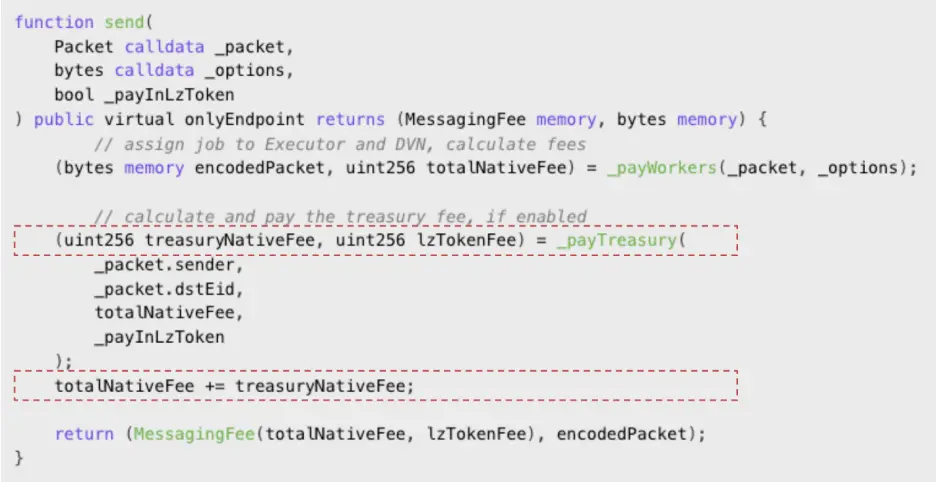
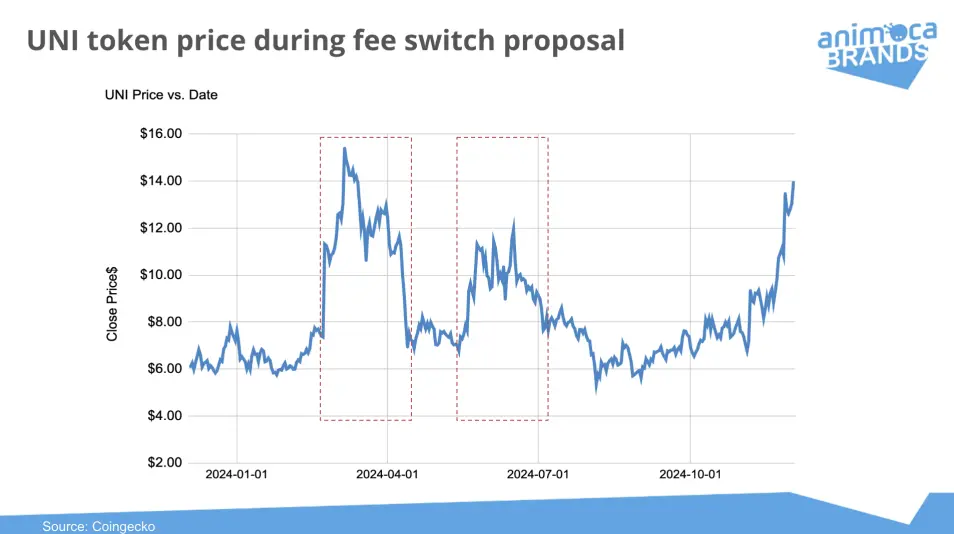
UNI token price during the fee switch proposal period
Looking ahead to the potential fee switch governance mechanism for the $ZRO token, we can find a similar case in Uniswap's $UNI token, which also has a similar protocol fee governance function.
When $UNI was launched in 2020, it included an option for the community to vote on whether to activate the fee switch. If the switch is activated, a portion of the decentralized exchange (DEX) trading fees would be redirected to the protocol, potentially benefiting $UNI holders. Since mid-2022, several fee switch proposals have been made, with each announcement triggering a significant increase in the price of $UNI. For example, when a new proposal was released in March 2024, the price of $UNI surged by 65%, but fell back after the voting results were announced. The proposal in May 2024 also exhibited a similar price fluctuation pattern.
However, to date, all fee switch proposals have been voted down or withdrawn. While introducing fees may align investor interests by creating value for the protocol and $UNI holders, it faces two main objections:
- Competitive Impact: Increasing protocol fees may reduce Uniswap's competitiveness, as it effectively taxes transactions, potentially raising costs for liquidity providers or users.
- Regulatory Risks: Distributing the generated value to token holders or stakers may raise regulatory concerns, especially if such practices are viewed as income distribution, which could touch on securities law issues.
It remains unclear whether $ZRO will face the same voting challenges as Uniswap's $UNI, with the key being the specific design of the fee voting mechanism, which has not yet been fully disclosed. Given the rapid growth and fierce competition in the cross-chain protocol space, LayerZero's current priority may be to focus on expanding market share rather than pursuing short-term value accumulation for $ZRO. Finding a balance between enhancing protocol value and maintaining competitive transaction costs will be crucial for LayerZero to promote sustainable long-term growth while also considering investor interests.
In a recent presentation, LayerZero's CEO Bryan Pellegrino announced during a Q&A session that the first public vote is scheduled for December 19, 2024, exactly six months after the token's release. The video of this presentation was released on November 19, 2024, and since then, the price of $ZRO has been on the rise.
Protocol Transaction Fees
In addition to the announced uses, the protocol's codebase also supports using $ZRO as an alternative currency for transaction fees. When the "payInLzToken" flag is set to TRUE, protocol transaction fees will be paid in $ZRO instead of the native token of the chain. However, the native token remains the default payment method for the protocol, and we have not yet seen projects actively switch to $ZRO for fee payments.
Accepting $ZRO as protocol fees can significantly expand the token's utility and demand. Integrated projects will need to maintain $ZRO reserves to cover ongoing protocol usage, creating sustained demand. As the LayerZero ecosystem develops, the demand for $ZRO will correspondingly increase, requiring larger reserves to support the growing cross-chain operations.
This cross-chain demand expansion for $ZRO will also create a compounding effect: as LayerZero connections expand, $ZRO will cover multiple ecosystems, becoming one of the most widely used tokens in the cross-chain space. Its broad availability has the potential to make $ZRO the preferred currency for cross-chain transactions, similar to the role of ETH in the EVM ecosystem.
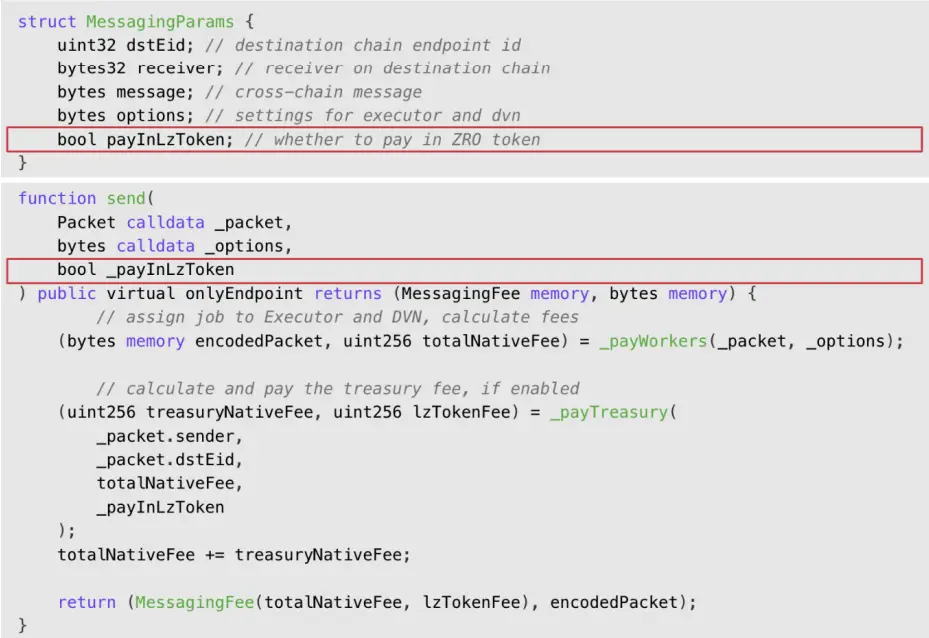
Despite the many benefits, converting the default native token to $ZRO still requires adequate preparation and incentives, such as:
$ZRO Deployment: Currently, $ZRO has been deployed on 8 chains, while LayerZero covers 90 networks. Expanding the application of $ZRO to more chains is crucial for its widespread adoption as the default fee token.
Project Incentives: Currently, the application scope of the on-chain native token is broader than that of $ZRO, so sufficient incentives need to be provided to encourage projects to choose $ZRO. Possible incentives include fee discounts when using $ZRO or establishing a single $ZRO reserve covering fees across all LayerZero-supported chains, making it more attractive for developers.
Operational Implementation: For the 50,000 contracts already deployed, the "_payInLzToken" flag needs to be manually enabled for each contract. To simplify this process, a unified switch at the protocol level may be needed, or one-time incentives could be offered to encourage project teams to adjust their contract settings.
Given the importance of $ZRO as the currency for protocol fees, it is essential to closely monitor LayerZero's plans and developments in promoting $ZRO as a fee token.

LayerZero's fee flow
Staking: The Distributed Verification Network (DVN) Framework of Cryptoeconomics
In October 2024, LayerZero and EigenLayer announced a partnership to develop an open-source cryptoeconomic framework for Distributed Verification Networks (DVNs). This framework aims to enhance the security of DVNs by introducing economic incentives, allowing users and decentralized applications (dApps) to consider factors beyond just technical stability when choosing a DVN.
The framework introduces an arbitration process that runs on a designated chain (e.g., Ethereum), allowing DVN staked assets to be verified when the validity of cross-chain messages is questioned. The specific process is as follows:
- Staking: Stakers lock assets into the DVN through EigenLayer's AVS, and these assets may be slashed if the DVN is found to be acting improperly or validating incorrectly.
- Validation: If a user or dApp questions the validity of a message, the framework triggers a round-trip message requesting other DVNs to verify the accuracy of the original message.
- Veto: If discrepancies are found, the veto contract escalates the decision, calling for a vote by token holders to determine whether to slash the DVN's stake.
- Slashing: If the vote confirms malicious or erroneous behavior, the staked assets will be slashed.
As an open-source framework, any DVN can adopt it and freely choose staking assets. LayerZero Labs' DVN will be the first to implement this framework on Ethereum, accepting $ZRO, $EIGEN, and $ETH as staking assets. Since LayerZero Labs DVN is still responsible for most of the protocol's validation work, the newly added staking pool may become a significant driver for $ZRO staking.
Specific incentives for $ZRO holders to participate in this staking pool have not yet been announced, making it difficult to predict the total amount of $ZRO that may be staked. Overall, staking helps regulate the supply of tokens in circulation, potentially similar to how a "central bank" balances demand and supply.
$ZRO Token Economics
The distribution and unlocking plan for $ZRO has been clearly outlined in the initial announcement. The total supply is 1 billion $ZRO tokens, allocated to four categories:
- 38.3% to the community: Including operational funds for the LayerZero Foundation.
- 32.2% to strategic partners: Such as investors and advisors.
- 25.5% to core contributors: Allocated to current and future team members.
- 4% for tokens repurchased by LayerZero Labs: For future community activities.
At the token generation event (TGE), 25% of the $ZRO tokens will be unlocked, all from the community category. The remaining unlocked tokens will be released linearly in the second and third years, with all 1 billion tokens fully unlocked by the end of the third year.
Of the 25% unlocked tokens:
- 8.5% is used to reward early contributors, distributed to the community through airdrops.
- 5% is allocated to the treasury of the LayerZero Foundation, including liquidity pools.
- 11.5% is reserved for future activities.
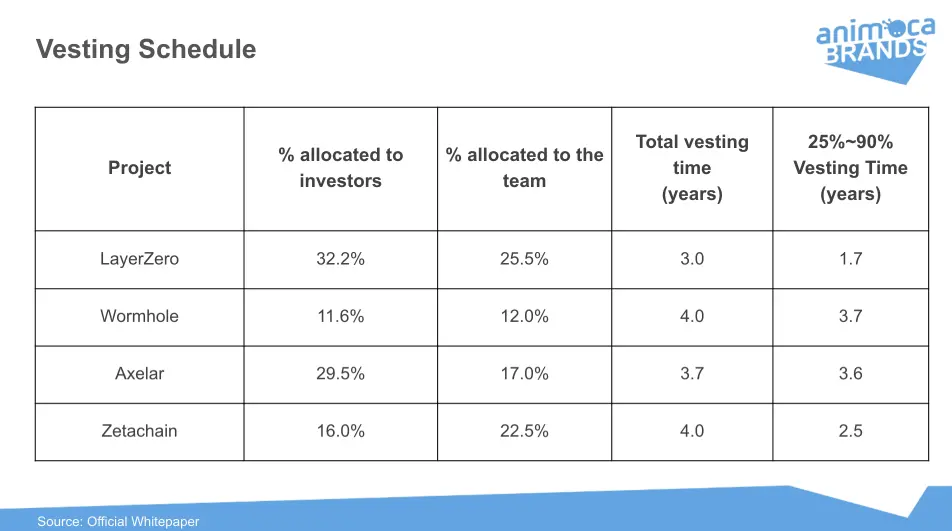
Token Unlocking Plan
By the second half of 2024, the circulating supply of tokens is expected to stabilize at about 11% of the total supply. This stability is anticipated since there will be no further unlocks in the first year. Starting in the second year, the supply will increase, with the remaining 75% of tokens fully unlocked by the end of the third year. As the unlocking rate accelerates, a significant portion of the tokens has been allocated to strategic partners (32.2%) and the team (25.5%), which may quickly enter circulation after unlocking.
The rapid unlocking for investors and the team may put time pressure on the LayerZero team to enhance the overall value of the project as soon as possible. We expect that by the end of the three-year unlocking period, approximately 65% of the $ZRO tokens will be in circulation (using Chainlink as a benchmark). This means that the circulating supply will increase fivefold compared to current levels. Such rapid supply growth will require a corresponding increase in the project's market capitalization to maintain price stability.
$ZRO Value Framework
To help readers establish a clear mental model for assessing the value of $ZRO, we propose a structured framework based on trends in the cross-chain space and LayerZero's strategic positioning within it. This framework aims to assist users in evaluating the $ZRO token by considering various factors, although specific parameters will vary based on individual perspectives on industry and project growth.
Our goal is not to provide a definitive combination of parameters but to offer a flexible framework that readers can adjust based on their analysis. It is important to note that this framework is not exhaustive or a final conclusion.
Method
One way to assess the $ZRO token is to apply the market capitalization to transaction volume ratio (MCTx), combined with LayerZero's projected three-year transaction volume scenarios. The reason for choosing the MCTx ratio is that transaction volume is a primary driver of protocol success, and transaction volume data is widely available for major projects, allowing us to evaluate a reasonable range. The three-year time span aligns with the unlocking period of the $ZRO token, and the cross-chain space is likely to maintain high growth momentum. Additionally, we will cross-validate by comparing with Layer 1 protocols like Ethereum and Solana.
Market Capitalization to Transaction Volume Ratio (MCTx)
First, we establish a reference market capitalization to transaction volume ratio (MCTx), using Wormhole, Axelar, and ZetaChain as benchmarks for comparison with LayerZero. These four protocols focus on cross-chain messaging and have released tokens in the past 12 months. We use data from the third quarter of 2024 as an observation window, tracking their average daily transaction volume and market capitalization, as this period is far from any short-term transaction volume peaks.
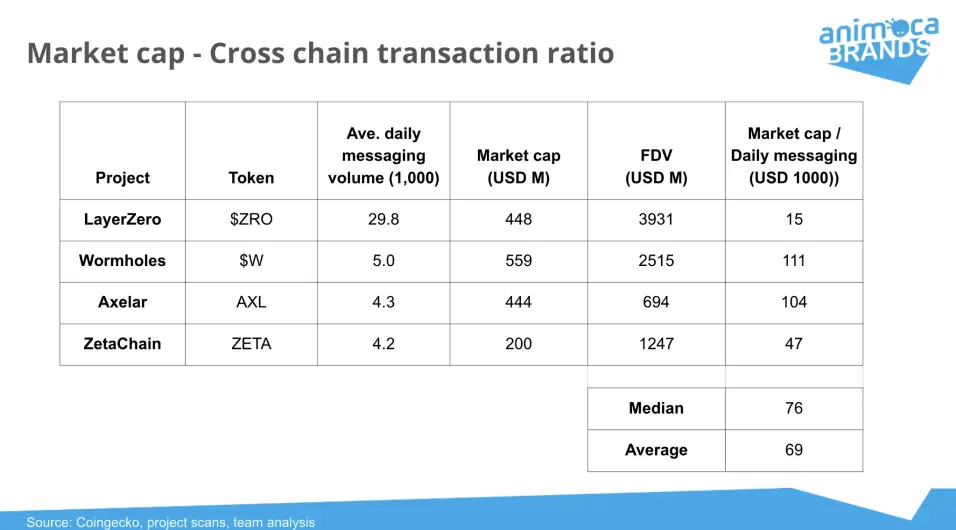
Market Capitalization to Cross-Chain Transaction Volume Ratio
The MCTx ratios of comparable projects range between 50 and 100, while LayerZero's current ratio is lower. One reason may be the relatively low circulating supply of $ZRO, which is related to its later TGE issuance and first-year unlocking plan. Another factor may be that $ZRO's utility is more limited compared to other projects. For example, AXL and ZETA tokens not only facilitate cross-chain transactions but also support the operations of their respective blockchains.
We expect that as the industry develops, MCTx ratios will converge among leading projects, with transaction volume becoming the dominant driver of protocol value. In the following examples, we use an MCTx ratio of 50 for illustration.
The next step is to create scenarios for LayerZero's future transaction volume. In our coverage of LayerZero's second part, we estimated the current cross-chain transaction/message volume to be approximately 3.5 million per month (about 120,000 daily), with LayerZero capturing 25% to 30% of the market share. We also anticipate that due to on-chain liquidity expansion and an increase in the number of chains, the annual transaction volume for the entire industry will grow by about 100%.
Based on these parameters, readers can formulate assumptions about LayerZero's future transaction volume over the next three years, considering different industry growth rates and LayerZero's market share combinations. In this process, readers may need to estimate daily transaction volumes under different scenarios and apply the MCTx ratio to derive an estimated range for the market capitalization of $ZRO at specific points in time.
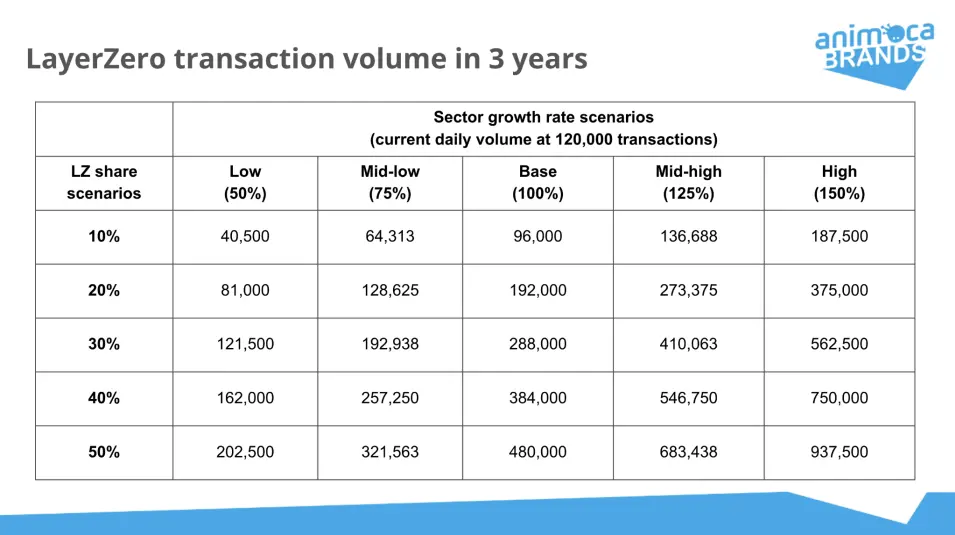
LayerZero's Future Three-Year Transaction Volume
By applying an MCTx ratio of 50, we can convert each daily transaction volume scenario into market capitalization estimates. This leads to market capitalization predictions for the $ZRO token over the next three years, with a conservative scenario of $2 billion and an optimistic scenario of $47 billion.

LayerZero's Estimated Market Capitalization Over the Next Three Years
To derive the present value of $ZRO, we introduce additional assumptions: a circulating supply of 65% for the $ZRO token and a 35% discount rate to adjust for future value. Based on these parameters, we calculate the current estimated value of the $ZRO token under each scenario.
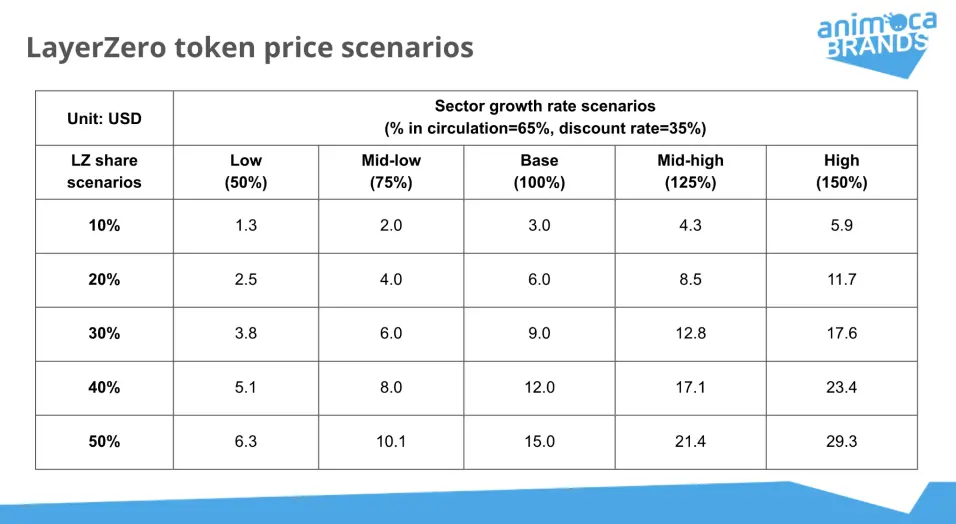
Possible Token Prices for LayerZero
Please remember that the methods described above are just one of many possible approaches to assessing $ZRO. The estimated value of $ZRO is highly sensitive to multiple factors, including the future growth rate of the cross-chain industry and LayerZero's market share within it. The future trajectory of the industry will largely depend on the broader cryptocurrency market environment, which itself is highly volatile. At the same time, LayerZero's market share will be influenced by its ability to provide robust technology that retains users and effectively seize emerging business opportunities.
Triangulation of MCTx Ratios
As an additional reference, the MCTx ratios used in the previous section can be triangulated. One approach is to convert the MCTx ratio into an MCTx fee ratio and compare it with leading infrastructure projects like Ethereum and Solana. In the first part of our LayerZero analysis, we estimated LayerZero's average transaction fee to be approximately $0.70. Based on this data, an MCTx ratio of 50 (i.e., $1,000 daily) results in an MCTx fee ratio of 196.
This brings LayerZero's three-year MCTx fee ratio close to the current ratios of Ethereum and Solana, which are 250 and 226, respectively. This similarity also implies that $ZRO needs to become a core part of the LayerZero ecosystem, just as $ETH and $SOL do in their respective networks, to support its multiplicative rationale. Whether $ZRO can achieve this remains a contentious topic, with arguments on both sides.
Supporting arguments may include:
- Cross-chain protocols and Layer 1 projects generate protocol revenue by charging transaction fees and paying fees to validation nodes.
- With the recent introduction of the EigenLayer partnership, the $ZRO token may play a significant role in LayerZero's DVN operations, similar to the applications of $ETH and $SOL in their respective networks.
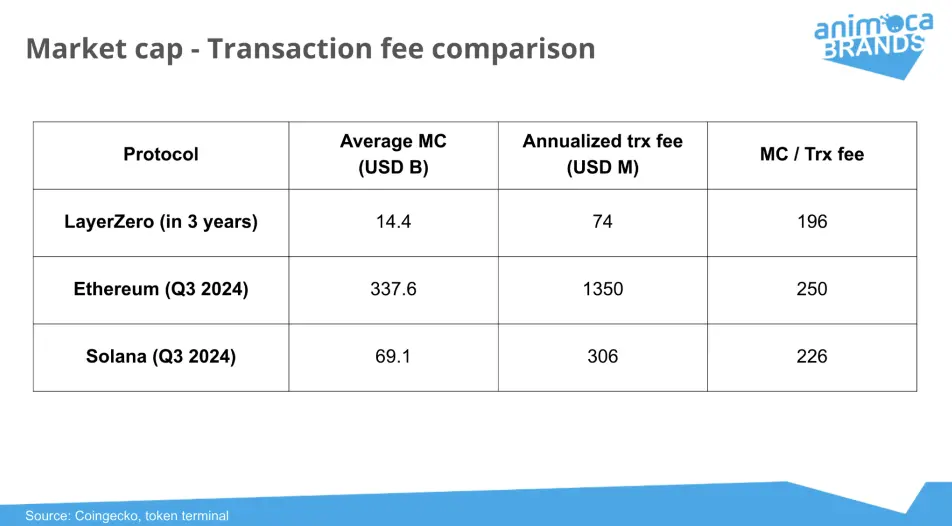
Market Capitalization to Transaction Fee Comparison
Counterarguments:
Possible counterarguments include:
$ZRO has not yet become the default transaction fee payment token: Currently, $ZRO is not the default fee token for all transactions, so its widespread adoption remains limited.
Fee switching introduces uncertainty: The fee switching feature brings uncertainty to users and developers, which may affect their decision-making, especially if the fee structure changes frequently.
$ZRO is not currently a "transaction currency": $ZRO is currently only used as a protocol fee payment tool and has not expanded to become a widely used transaction currency. Therefore, its primary function as a major token for cross-chain transactions has not yet been fully realized.
$ZRO is not the only token used for DVN staking: While $ZRO plays an important role in the LayerZero ecosystem, it is not the only token that can be used for DVN staking, which limits its exclusivity in certain contexts.
Different views on these factors may affect market participants' assessments of the MCTx fee ratio and MCTx transaction volume ratio, leading to adjustments based on varying assumptions about $ZRO's future role.
Other Risks to Consider
Robustness of LayerZero V2 Architecture
LayerZero V2 was launched in December 2023 and has not reported any security vulnerabilities to date. The protocol's confidence in its design is reflected in its $15 million bug bounty, one of the highest in the industry.
One of the core aspects of LayerZero's security model is the absence of collusion between the DVN (Decentralized Validation Network) and the executors. So far, this design has worked well, partly because the executors are entirely operated by LayerZero while the DVN remains decentralized. However, as LayerZero allows external parties to build executors, the possibility of collusion has increased.
Moreover, as more projects adopt LayerZero as their primary cross-chain asset transfer and governance infrastructure, the motivation for malicious actors to attempt to attack the network will gradually increase. If a security vulnerability occurs, it could significantly damage LayerZero's growth momentum, slow future development, and negatively impact the value of the $ZRO token.
Deployment of $ZRO Utility
By the end of 2024, the utility of $ZRO has not been fully realized. The high expectations for $ZRO need to be supported by actual usage, such as:
Semi-annual fee switching voting: Introducing a fee switching voting mechanism to enhance the value accumulation expectations of token holders.
Defaulting $ZRO as the fee currency: Increasing the holding of $ZRO in decentralized applications (dApps) and improving the velocity of funds.
Adoption of $ZRO as a universal transaction currency: Expanding the use cases of $ZRO so that it is not only used within LayerZero but also becomes a widely accepted cross-chain token.
Achieving these utility goals would significantly enhance the role of the $ZRO token within the LayerZero network. However, as technology advances, LayerZero will face not only development challenges but also the need for strategic efforts in user engagement, partnerships, and ecosystem incentives to comprehensively integrate these utilities.
Conclusion
The $ZRO token is planned to become a core part of the LayerZero ecosystem, providing key utilities for governance, protocol fees, and DVN staking. Additionally, as the protocol evolves, the role of $ZRO is expected to further expand, potentially becoming a widely used cross-chain transaction currency. We anticipate that over the next three years, the utility of LayerZero and $ZRO will experience a rapid growth phase.
Although $ZRO currently lacks direct utility, we have outlined a potential assessment model that helps readers provide context for the future development of the protocol through MCTx ratios and predictions of future transaction volumes, assisting in evaluating the role of $ZRO in the protocol's future.
免责声明:本文章仅代表作者个人观点,不代表本平台的立场和观点。本文章仅供信息分享,不构成对任何人的任何投资建议。用户与作者之间的任何争议,与本平台无关。如网页中刊载的文章或图片涉及侵权,请提供相关的权利证明和身份证明发送邮件到support@aicoin.com,本平台相关工作人员将会进行核查。




